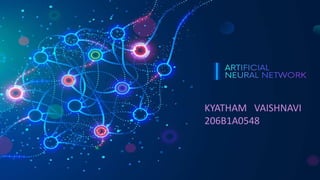ANN.ppt[1].pptx
•Download as PPTX, PDF•
0 likes•28 views
it is about the artificial neural network
Report
Share
Report
Share

Recommended
Recommended
More Related Content
Similar to ANN.ppt[1].pptx
Similar to ANN.ppt[1].pptx (20)
Neural networks are parallel computing devices.docx.pdf

Neural networks are parallel computing devices.docx.pdf
Recently uploaded
This presentation was provided by William Mattingly of the Smithsonian Institution, during the closing segment of the NISO training series "AI & Prompt Design." Session Eight: Limitations and Potential Solutions, was held on May 23, 2024.Mattingly "AI & Prompt Design: Limitations and Solutions with LLMs"

Mattingly "AI & Prompt Design: Limitations and Solutions with LLMs"National Information Standards Organization (NISO)
Recently uploaded (20)
Industrial Training Report- AKTU Industrial Training Report

Industrial Training Report- AKTU Industrial Training Report
Instructions for Submissions thorugh G- Classroom.pptx

Instructions for Submissions thorugh G- Classroom.pptx
Basic phrases for greeting and assisting costumers

Basic phrases for greeting and assisting costumers
slides CapTechTalks Webinar May 2024 Alexander Perry.pptx

slides CapTechTalks Webinar May 2024 Alexander Perry.pptx
Danh sách HSG Bộ môn cấp trường - Cấp THPT.pdf

Danh sách HSG Bộ môn cấp trường - Cấp THPT.pdf
Forest and Wildlife Resources Class 10 Free Study Material PDF

Forest and Wildlife Resources Class 10 Free Study Material PDF
MARUTI SUZUKI- A Successful Joint Venture in India.pptx

MARUTI SUZUKI- A Successful Joint Venture in India.pptx
Mattingly "AI & Prompt Design: Limitations and Solutions with LLMs"

Mattingly "AI & Prompt Design: Limitations and Solutions with LLMs"
UNIT – IV_PCI Complaints: Complaints and evaluation of complaints, Handling o...

UNIT – IV_PCI Complaints: Complaints and evaluation of complaints, Handling o...
Basic Civil Engineering Notes of Chapter-6, Topic- Ecosystem, Biodiversity G...

Basic Civil Engineering Notes of Chapter-6, Topic- Ecosystem, Biodiversity G...
Solid waste management & Types of Basic civil Engineering notes by DJ Sir.pptx

Solid waste management & Types of Basic civil Engineering notes by DJ Sir.pptx
The Benefits and Challenges of Open Educational Resources

The Benefits and Challenges of Open Educational Resources
Matatag-Curriculum and the 21st Century Skills Presentation.pptx

Matatag-Curriculum and the 21st Century Skills Presentation.pptx
ANN.ppt[1].pptx
- 2. CONTENT • Abstract • Introduction • What are ANNs? • How ANNs Work? • Learning paradigms • Applications areas • Advantages and Disadvantages • Conclusion
- 3. ABSTRACT Welcome to the world of Artificial Neural Networks (ANNs)! In this presentation, we'll take an easygoing dive into the mysteries behind ANNS and demystify their workings. Get ready to explore the fascinating world of Machine learning! Artificial Neural Networks are computational models inspired by the human brain's neural network. They consist of interconnected neurons that process information. ANNs are used in various applications such as image recognition, natural language processing, and predictive analysis. ANNS work by simulating the behavior of biological neurons each neuron receives input signals, applies weights to them, and passes the result through an activation function this process is repeated multiple times in layers, allowing ANNs to learn and make predictions based on input data. To train ANNs, we use a technique called Backpropagation
- 4. Welcome to the world of Artificial Neural Networks (ANNs)! In this presentation, we'll take an easygoing dive into the mysteries behind ANNs and demystify their workings. Get ready to explore the fascinating world of machine learning Introduction
- 5. Artificial Neural Networks are computational models inspired by the human brain's neural network. They consist of interconnected neurons that process information. ANNs are used in various applications such as image recognition, natural language processing, and predictive analysis. What are ANNs?
- 6. ANNs work by simulating the behavior of biological neurons. Each neuron receives input signals, applies weights to them, and passes the result through an activation function. This process is repeated multiple times in layers, allowing ANNs to learn and make predictions based on input data. How ANNs Work
- 7. Back Propagation Back-propagation is an example of supervised learning is used at each layer to minimize the error between the layer’s response and the actual data The error at each hidden layer is an average of the evaluated error Hidden layer networks are trained this way
- 8. Number of neurons Many neurons: Higher accuracy Slower Risk of over‐fitting Memorizing, rather than understanding The network will be useless with new problems. Few neurons: Lower accuracy Inability to learn at all Optimal number.
- 9. Learning Paradigms Supervised learning Unsupervised learning Reinforcement learning
- 10. Supervised learning This is what we have seen so far! A network is fed with a set of training samples (inputs and corresponding output), and it uses these samples to learn the general relationship between the inputs and the outputs. This relationship is represented by the values of the weights of the trained network.
- 11. Unsupervised learning No desired output is associated with the training data! Faster than supervised learning Used to find out structures within data: Clustering Compression
- 12. Reinforcement learning Like supervised learning, but: Weights adjusting is not directly related to the error value. The error value is used to randomly, shuffle weights! Relatively slow learning due to ‘randomness’.
- 13. Applications Areas Function approximation including time series prediction and modeling. Classification including patterns and sequences recognition, novelty detection and sequential decision making. (radar systems, face identification, handwritten text recognition)
- 14. Advantages / Disadvantages Advantages Adapt to unknown situations Powerful, it can model complex functions. Ease of use, learns by example, and very little user domain‐specific expertise needed Disadvantages Forgets Not exact Large complexity of the network structure
- 15. Conclusion Artificial Neural Networks are an imitation of the biological neural networks, but much simpler ones. The computing would have a lot to gain from neural networks. Their ability to learn by example makes them very flexible and powerful furthermore there is need to device an algorithm in order to perform a specific task.
- 16. Thank You